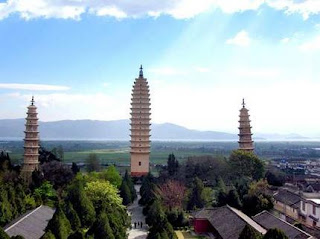History
Dali is the ancient capital of both the Bai kingdom Nanzhao, which flourished in the area during the 8th and 9th centuries, and theKingdom of Dali, which reigned from 937-1253. Situated in a once significantly Muslim part of South China, Dali was also the center of the Panthay Rebellion against the reigning imperial Qing Dynasty from 1856-1863.
Dali is also famous for the many types of marble it produces, which are used primarily in construction and for decorative objects. In fact, Dali is so famous for the stone that the name of marble in Chinese is literally "Dali Stone" (Chinese: 大理石; pinyin: dali shi).
Dali is now a major tourist destination, along with Lijiang, for both domestic and international tourists.
Old Town and new city
Dali and Yunnan's capital Kunming are only a 40-minute flight apart. Dali's newly finished administrative district that houses the newly opened Dali International Convention Center is in Longshan District. The Dali government's urban planning keeps its old and new districts separate, so those coming here for the first time often feel they have entered a time tunnel.
The "new city" is known as Xiaguan and is south of the old city. The old city was built during Ming Dynasty emperor Hongwu's reign (1368–1398). Owing to the distance between them, the old city is still peaceful and quiet.
Geography
Dali is located on a fertile plateau between the Cangshan mountains to the west and Erhai lake to the east. It has traditionally been settled by the Bai and Yi minorities. It is also the capital of the Dali Bai Autonomous Prefecture 。
More information ,please check from :








没有评论:
发表评论